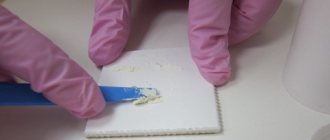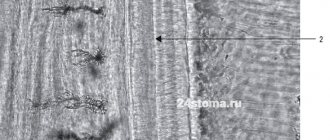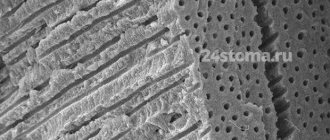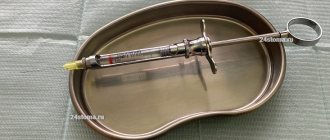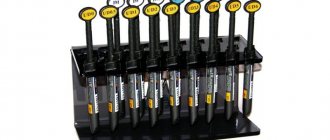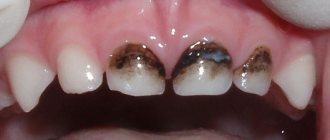Unitem is a two-component, three-color zinc phosphate dental cement.
Dental cement Unicem is available in three colors (white, light yellow, golden yellow) or bactericidal, containing the optimal amount of a bacteriostatically effective form of silver.
Zinc phosphate cement Unitsem three-color is used for fixing inlays, pin teeth, metal, plastic, porcelain, metal-ceramic crowns and bridges, for filling teeth to be covered with crowns, as an insulating spacer (for example, Ionosit) when filling teeth with amalgams, silicate and silicophosphate cements .
Unicem bactericidal is used in pediatric dentistry for filling baby teeth.
Properties
Unicem is a universal, improved zinc phosphate dental cement with high mechanical compressive strength: 90 MPa with a powder to liquid ratio of 1.5:1 (for fixation), 121 MPa with a powder to liquid ratio of 2:1 (for filling).
Cement is formed by mixing a powder containing zinc oxide with modifying additives with a liquid that is orthophosphoric acid of reduced activity. The thickness of the cement film for fixation does not exceed 25 microns.
The presence of silver in bactericidal cement prevents the development of secondary caries and reduces the likelihood of primary caries in primary teeth.
Dental cement Unitem meets the requirements of GOST R 51744-2001.
How to mix phosphate cement
- Product catalog Microscopes Microscopes
- Anesthetics
- Healing materials
- Adhesive systems
- Fiberglass pins
- Light curing
- Disobturation of root canals Materials
- Tools
- Tools
- Materials for relining the prosthesis
- Plasters
- Auxiliary means (eg conalor, reinforcing mesh)
- Compressors
- Equipment and consumables for sterilization Equipment for sterilization
- Densim Tools
- Visiographs
- Desensitizers and sealants
- DIO implants (DIO implants Korea)
- Sets
- Physiodispenser Saeshin
- DIO (Korea)
- home
- Restoration
- Cements for permanent fillings
- Chemical curing
- Adhesor/Adhesor - zinc phosphate cement (80 g + 55 g)
Adhesor/Adhesor - zinc phosphate cement (80 g + 55 g)
- Product description
- Delivery
- Payment
- Ask a Question
Related products
Dental tray LMS for 8 instruments with lid
Endogel No. 2 syringe - material for chemical-mechanical expansion, cleaning, shaping and antiseptic treatment of tooth root canals (gel 3 ml)
Viedent set - material for filling root canals of teeth (20 g + 10 ml)
Two-component argenate - material for silvering infected and difficult-to-pass canals, carious milk teeth (4ml+3ml)
Dental tray with lid and storage for LSKB burs
Rectangular tray LMPr 400x300x45
Stomaflex Light/Stomaflex light-C-Silicone impression material of low viscosity and higher fluidity (paste 130 g)
Dental tray with lid and storage for endocanal instrument LSCE
Viedent - material for filling root canals of teeth (paste 4 g + paste 4 g)
Polident No. 4 - paste for final processing of fillings (paste 6 g)
Rectangular tray LMPr 300x220x30
Unitem - instructions for use
Material stored or transported at low temperatures must be kept at room temperature for at least 1 hour before use.
The liquid is dosed with a dropper, pipette or using a glass rod, the powder is dosed with a measuring spoon. For mixing, use a clean glass plate and a chrome spatula. Normal temperature conditions during mixing are +23±1°C and relative humidity (50±10)%. At temperatures above +23°C, the plate should be kept in cold water or in the refrigerator for 2-3 minutes.
On a dry glass plate, mixing the powder and liquid should be done gradually.
First, half the measured powder is mixed with the liquid, then the remaining portion is added in small portions until a homogeneous mass is obtained. Mixing time should not exceed 60 seconds.
To fix dentures, the normal density of the zama is achieved by mixing 1 dosage measure of powder (0.25-0.30 g) with 4 drops of liquid (0.18-0.20 g). The cement paste has a creamy consistency and remains plastic on glass for 2-2.5 minutes, and hardens in the oral cavity within 8 minutes.
For filling teeth, the normal consistency of cement paste is achieved by mixing 1 dosage measure of powder (0.25-0.30 g) with 3 drops of liquid (0.13-0.15 g). The cement paste has a thick, uniform consistency and retains plasticity on glass for 1-1.5 minutes, and hardens in the tooth cavity within 6 minutes.
Before filling or fixing, it is recommended to isolate the tooth from saliva, treat the prepared cavity or tooth stump with a cotton swab soaked in Anhydrin liquid, and dry it with a stream of warm air. It is not recommended to use ethyl alcohol for drying.
During the hardening period (2 hours), the filling must be covered with protective varnish or hydrophobic gel Axil from the effects of saliva.
Hoffmann' S Germany
Hoffmann ́s Cement normalhärtend Normal-curing phosphate cement Area of application: Fixation of crowns, bridges and inlays, fixation of orthodontic rings, fixation of pins and screws, temporary fillings Release form: Powder: 100 g Liquid: 40 ml Set: 35 g powder and 15 ml liquid B assortment in 15 different colors
Hoffmann’s Cement schnellhärtend Zinc phosphate cement, fast curing Area of application: Fixation of crowns, bridges and inlays, fixation of orthodontic rings, fixation of pins and screws, temporary fillings Release form: Powder: 100 g Liquid: 40 ml Set: 35 g powder and 15 ml liquid Available in 15 different colors
Hoffmann's Universal Cement Universal zinc phosphate cement Used with Hoffmann's zinc phosphate cement normal-curing, rapid-curing and carboxylate cement fluids. Area of application: Fixation of crowns, bridges and inlays, fastening of orthodontic rings, temporary fillings, fixation of pins and screws, linings for all filling materials (only with normal curing liquids and carboxylate cement) Release form: Powder: 100 g Available in 15 different colors
Hoffmann's Provisorischer Cemen Zinc oxide based cement Area of application: Temporary fillings. Release form: Powder: 50 g Liquid: 40 ml
Hoffmann ́s FARBTÖNE Set of colored cements for fixation Area of application: Try-in and permanent fixation of crowns and bridges made of oxide ceramics (zirconium oxide and aluminum oxide), as well as lithium ceramics with a bending strength of more than 200 MPa Capabilities: 1. Correction of the color of the structure for adjustment to the remaining teeth: - Lightening (Color 01 and mixed tones from 01) - Darkening (Colors 07, 10, 11) - Color correction of the structure (All colors and mixed tones) 2. Adjustment of differently colored stumps 3. Imitation of living pulp (Color 15) Release form: Fixing liquid 40 ml Test liquid 40 ml Powder 1 x 100g, 4 x 30g
Hoffmann ́s Glass mixing Mixing glass, crystal Area of application: Professional base for mixing all Hoffmanns cements. During the entire mixing process, the glass maintains a constant temperature, even when heat is generated. The glass has a sufficiently large surface for stretching, is resistant to scratches, also from metal spatulas, and is easy to clean. The solid design ensures stable and reliable use. Size: 150 x 75 x 20 mm Weight: 596 g
New bone cements based on calcium and magnesium phosphates for replacing bone tissue defects
Scientists from the Institute of Metallurgy and Materials Science named after.
A.A. Baikov RAS have created new bone cements based on calcium and magnesium phosphates for use in dentistry, reconstructive surgery and orthopedics for replacing bone tissue defects and as a drug carrier. The created cements fill bone defects of any shape and can be used as an adhesive binder when connecting bone fragments to each other or to a titanium implant. Over time, natural bone tissue replaces the cement. Due to the absence of an exothermic reaction during mixing, as well as the absence of highly acidic and alkaline components, such cements can be injected with a drug, for example, an antibiotic, to reduce the risk of infection during surgery. The results were published in the journal Bioactive Materials, the work was supported by the Russian Foundation for Basic Research grant 18-33-20170. Today, in surgery and orthopedics, bone cements based on insoluble bioinert polymer acrylate are widely used, the disadvantages of which include an exothermic reaction leading to burns and necrosis of surrounding tissues. Such cements are insoluble in the body and do not promote natural bone growth. Inorganic calcium phosphate bone cements, curing in situ, are capable of completely replacing bone defects of various shapes and sizes, and are also characterized by high strength compared to materials in the form of porous granules and blocks during implantation. The problem with the use of calcium phosphate bone cements is the need for a chemical reaction between the powder and the liquid, which leads to the use of a highly acidic cement liquid and a subsequent acidic reaction at the implantation site and associated necrosis of bone tissue.
Scientists from the IMET RAS studied the effect of the ratios of components in the calcium phosphate-magnesium phosphate-magnesium oxide system in a wide range of concentrations on the ability of bone cements to set and harden to obtain pH neutral compositions in the presence of weakly acidic solutions of sodium phosphate as a cement fluid. An original method for synthesizing a cement powder precursor in one vessel was developed, which makes it possible to achieve the most uniform distribution of phases in bone cement. Together with scientists from Moscow State University. M.V. Lomonosov and the Federal State Budgetary Institution "National Medical Research Center of Radiology" of the Ministry of Health of Russia, physicochemical and biological studies of materials were carried out and it was established that, depending on the complex of properties, setting time - mechanical properties - cytocompatibility, optimal compositions of bone cements.
The presence of MgO in the initial powders leads to a significant increase in the strength of cements. At the same time, a large amount of MgO in the materials of the (Ca+Mg)/P=2 system led to an alkaline reaction and cytotoxicity of the materials observed in in vitro experiments. In the developed cement powders with the ratio (Ca + Mg)/P = 1 67 MgO reacted completely with the cement fluid, resulting in a neutral pH of cements in distilled water and a medium simulating extracellular body fluids. A more than threefold increase in compressive strength values was achieved compared to other cytocompatible cements with (Ca+ Mg)/P = 1.5. Thus, the optimal ratio (Ca + Mg)/P = 1.67 was identified, the resulting cements provided a setting time of 13-15 minutes, sufficient for insertion and installation into the site of a bone defect, high compressive strength up to 22 ± 3 MPa, solubility in liquids that simulate extracellular fluids of the body, lack of cytotoxicity and the ability to support cell adhesion and spreading. At the same time, preliminary tests have shown that, due to the neutral pH of the developed cements and the absence of an exothermic reaction, such cements, when antimicrobial drugs are introduced into them, exhibit activity against gram-negative bacteria and can be used for local antimicrobial therapy.
